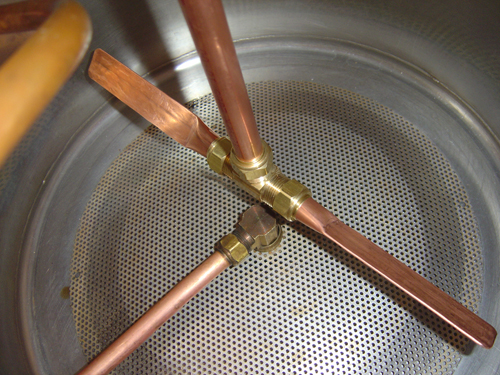Hi all,
I am in the process of building a motorized mash stirrer for my Blichmann BrewEasy using copper tubing flattened into fins like this (H/T to @Lonnie-Mack):

Given that the manual for the BrewEasy says you should leave the bottom 2/3 of the mash bed undisturbed when stirring the mash because it acts as a filter for the wort, I want to make the length of the mash stirrer adjustable to account for different size batches and grain bills. My initial plan was to make the bottom part of the stirring arm out of 3/4" tubing and the top part of the stirring arm out of 1/2" tubing with the 1/2" tubing placed inside of the 3/4" tubing. I could then adjust the location of the stirrer by sliding the two halves of the arm lengths closer together/further apart and secure them with a shaft coupling like this. However, I have been unable to locate a shaft coupling that is big enough to accommodate a 3/4" copper pipe (much less one that can accommodate a second smaller pipe on the other end.) Can anybody suggest something other than a shaft coupling that I might be able to use for this purpose or another solution on how I can make the stirrer arm adjustable? Thanks!
I am in the process of building a motorized mash stirrer for my Blichmann BrewEasy using copper tubing flattened into fins like this (H/T to @Lonnie-Mack):
Given that the manual for the BrewEasy says you should leave the bottom 2/3 of the mash bed undisturbed when stirring the mash because it acts as a filter for the wort, I want to make the length of the mash stirrer adjustable to account for different size batches and grain bills. My initial plan was to make the bottom part of the stirring arm out of 3/4" tubing and the top part of the stirring arm out of 1/2" tubing with the 1/2" tubing placed inside of the 3/4" tubing. I could then adjust the location of the stirrer by sliding the two halves of the arm lengths closer together/further apart and secure them with a shaft coupling like this. However, I have been unable to locate a shaft coupling that is big enough to accommodate a 3/4" copper pipe (much less one that can accommodate a second smaller pipe on the other end.) Can anybody suggest something other than a shaft coupling that I might be able to use for this purpose or another solution on how I can make the stirrer arm adjustable? Thanks!
Last edited:

























![Craft A Brew - Safale S-04 Dry Yeast - Fermentis - English Ale Dry Yeast - For English and American Ales and Hard Apple Ciders - Ingredients for Home Brewing - Beer Making Supplies - [1 Pack]](https://m.media-amazon.com/images/I/41fVGNh6JfL._SL500_.jpg)































